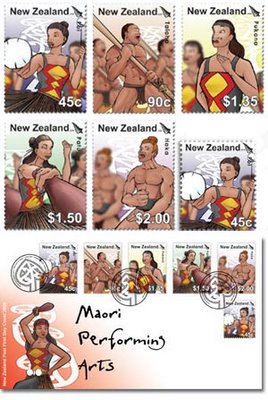Maori Performing Arts

Traditional Maori Performing Arts;
kapa haka is a growing part
of Maori culture.
Ranging from the haka (war dance)
to the more peaceful
waiata-a-ringa action songs,
using the Poi, Patu or Taiaha,
kapa haka affirms Maori identity
for those immersed in their
cultural roots, and those
who wish to return and
be a part of these
historical performances.
Kapa haka has been a
strong spiritual and cultural
part of Maori tradition.
Kapa haka is unique as
performers sing, dance and
coordinate expression and
movement into each dance.
Each action is deliberate
and links to the words sung.
The strong vocals providing
the music is unlike many cultures.
Beautiful harmonies and carefully
executed body language
combined produce
a clear and
vibrant performance.
Poi - 45c
The poi, if used by an
experienced performer,
are manipulated and twirled
to the music and song
of many performances.
It is believed that the poi
has been a means of training
warriors to strengthen
their wrists.
During performances however,
it is the women who use
the long or short poi either
singularly, doubly or in
a quad formation.
The long poi is mainly
used for spinning
movements and actions.
The short poi was
used for flicking,
catching and slapping
movements to mark
a rhythm of a song.
Taiaha - 90c
The taiaha is a long staff
measuring up to 1.5m in length.
It has a carved face with
an arero (tongue) on
the end of it,
often incorporating ornate carvings,
feathers or paua shell.
A work of art as well as
a weapon, this spear is
used in the kapa haka.
Pukana - $1.35
The pukana, or widening of
the eyes, is part of the
performance usually linked
to wiri, or shaking of the hands.
These expressions are used
at various times in the
performance to reinforce meaning
and add force to the words.
Pukana is described as
the innermost expression of
wairua (soul) being released.
Patu - $1.50
The patu, mere, or short club,
is popular for female performers
in kapa haka.
The mere symbolises the
facing and overcoming
of life's challenges
and difficulties.
Haka - $2.00
The haka can be performed
with or without weapons,
and this stamp image shows
the haka with precise
choreographed actions.
From pre-European times,
the haka was performed
without weapons,
but with well defined actions.
Following the First World War
the haka developed in vibrant
and vigorous forms,
used to express many private
or public sentiments.
First day cover
The superb graphics used in
this stamp issue to commemorate
Maori Performing Arts are
presented on this first day cover.
All stamps are affixed and
the vivid background image
exaggerates the active nature
of the issue.
Technical details
Date of Issue: 7 June 2006
Designer:
Abel Vaireka, Brownstone Design Group,
Petone, Wellington
Printer:
Southern Colour Print, DunedinStamp
Size: 40mm x 30mm (vertical)
Self-adhesive stamps:
30mm x 25mm (vertical)
Sheet Size:
25 stamps per sheet
Paper Type:
Tullis Russell 104gsm
red phosphor gummed
stamp paperPerforation: 14
if you collect New Zealand
and have any that you will
trade please let me know.
Budrow@Highland.Net
now for a bit a fun nothing
to answer just be the 5th
person to e-mail me and
you will get a FDC.
just say that you are
trying for the cover.
Budrow@Highland.Net


0 Comments:
Post a Comment
<< Home